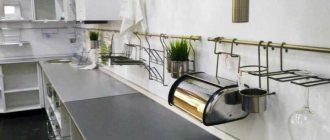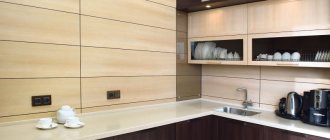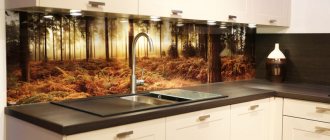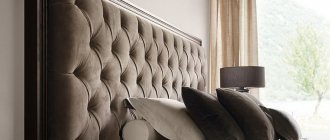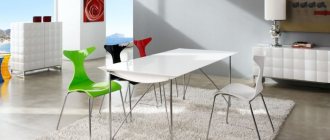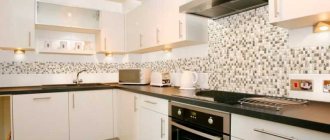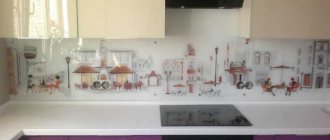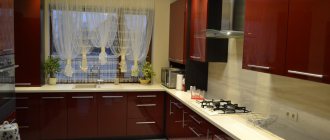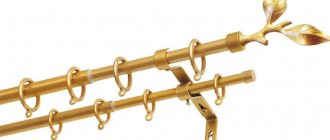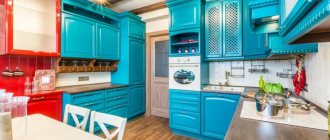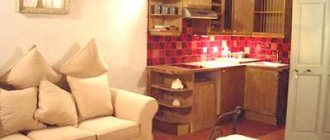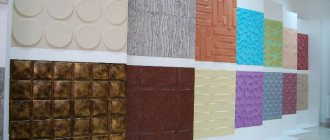Variety of wall panel models
Decorating a kitchen using wall panels is an economical and practical option for transforming a room. Modern finishing materials greatly speed up and simplify the repair process and perfectly mask unsightly walls.
By purchasing this type of finishing for renovation, you can decorate the kitchen according to your taste and preference, choose the desired color, tone, pattern, texture. And you will spend a very small amount of money.
Each type of panel has its own pros and cons, advantages and disadvantages. Panels imitating patterns of wood, natural stone, and brickwork are always relevant and in demand.
Design panels
The finishing material is selected taking into account the ideal combination with the countertop and kitchen furniture facades, with the color of the dining table and decorative elements.
Particular attention in the design of walls is paid to the color scheme. If the color of the apron and tabletop match, the design looks expensive and stylish. Before carrying out the planned renovation, you need to look at new design developments and photos of wall panels for the kitchen.
Among the huge assortment, choose panels to suit your interior. A paneled kitchen will look completely different. The products will highlight the advantages of the kitchen and will look perfect in any interior.
Wooden wall panels
Wooden panels are appropriate in any interior . Wood looks expensive and elegant, making the kitchen warmer and more comfortable. Combines with any colors, looks advantageous in glossy and matte versions. Oak and birch, pine and linden are used for production.
The material is safe for human health and environmentally friendly, durable and shock-resistant. Natural wood or veneer is used to make panels. The second option is cheaper, but in terms of physical characteristics it is not inferior to natural wood.
Disadvantages include special care requirements. To prevent the wooden apron from deteriorating due to water and becoming moldy, it is treated with wax and polished, and covered with a protective varnish layer. This procedure is carried out once every 1-2 years. If this is not done, then dust and food debris will be absorbed into the pores of the wood, which will lead to the appearance of dangerous bacteria, and the panel will lose its visual appeal.
Different types of panels
Wall decoration, depending on the characteristics of the interior, is made with products of different colors and textures, made using different technologies. To carry out budget repairs, panels made of plastic, laminated chipboard, plywood and MDF, and affordable and varied PVC are used.
To decorate luxury interiors, metal, glass and wood panels and artificial stone are used. Installation of wall panels in the kitchen can be done with your own hands, without professional skills.
Walls and even ceilings are decorated using tile, slatted, and sheet products.
All types in the photo
For the production of wall panels, different types of materials can be used, depending on which these products can be classified into the following types:
- plastic;
- glass (from hardened and non-hardened material);
- MDF panels;
- laminated products from chipboard or plywood;
- wooden;
- artificial stone products
- panels from postforming.
In addition to appearance and size, the products differ from each other and in price. The most affordable and inexpensive are PVC panels for the kitchen , which have fairly high consumer properties and are ideal among the so-called budget renovation options. Wooden products can be considered the most impractical due to the properties of wood to absorb moisture, but if you use wax protection, this can be neglected, especially considering the aesthetic characteristics.
In terms of cost, the most expensive panels are made from postforming, artificial stone and glass, but this is compensated by high performance and aesthetic characteristics.
Photos of kitchens with wall panels:
Kitchen wall panels made of MDF
Kitchen ceiling made of plastic panels
Photo of finishing the kitchen apron with MDF panels
Kitchen apron made of PVC panels
You can also look at the types of wall panels in detail here:
Practical MDF panels
Sufficiently dense, strong, durable MDF kitchen wall panels are inexpensive. Mold does not grow under them, they are not afraid of scratches or other minor damage. They tolerate sudden changes in temperature and humidity in the room, and are washed without much effort.
Laminated waterproof panels are recommended for the kitchen. They have an aesthetic appearance, perform a protective and soundproofing function, have a wide variety of colors, do not deform from moisture, and are installed quickly and easily.
Laminated finishing material is not inferior in appearance and practicality to ceramic tiles, but costs much less. Even an inexperienced craftsman can install the cladding.
Made from MDF, laminated chipboard or plywood
Panels, for the production of which the method of pressing wood material is used, can easily be installed in the kitchen, since there is protection from moisture - lamination, especially double-sided. These products include MDF panels for the kitchen, products made from chipboard and plywood.
In the kitchen, panels made of MDF and plywood are most often used, while the second has the best moisture resistance. Products made from chipboard, even with double-sided lamination, have lower mechanical strength and are not resistant to changes in temperature and humidity.
Laminated chipboard in the kitchen
When choosing these panels for the kitchen, you should also take into account their low fire resistance, so it is better not to use them to decorate an apron near a gas stove. For rooms equipped with electric stoves, they are quite a suitable option, especially since they are not inferior in appearance to plastic ones: the applied lamination layer can imitate any pattern, so they will organically fit into any design.
Among the advantages, it should be noted that it has fairly high mechanical strength and ease of maintenance using non-abrasive detergents.
Protective layer for panels
In production, MDF panels are covered with plastic, film or painted with acrylic paints and secured with several layers of varnish. The plastic coated panel is more durable. The waterproof surface is easy to care for using various detergents. It is not advisable to clean the film coating with aggressive cleaning agents.
Photo printing is applied to the base coated with paints in different ways and covered with varnish. Nowadays, wall panels with photo printing with a 3D effect are often installed.
In the kitchen, thanks to the original cladding, a unique three-dimensional picture appears. Thematic designs give the kitchen a special charm and sophistication.
Similarity to ceramic tiles
Kitchen wall panels made of PVC resemble ceramic tiles in appearance. Lightweight polyvinyl chloride is easy to install and wash off from dirt, and does not deteriorate from exposure to moisture. The material does not deform due to sudden temperature changes, but it is easily damaged due to careless use.
It’s easy to choose the optimal and desired option for your interior in the desired color and design among the huge assortment offered in shopping centers and online stores.
Products made from polyvinyl chloride have low prices; even a novice craftsman without construction experience can install them in the kitchen, with little time and effort.
The facing material is sold in rolls, square tiles and elongated planks of various standard sizes and models. Plastic panels are popular and in demand; they are often used for kitchen renovations on a budget.
Types of wall panels
Before you begin installing kitchen wall panels, you need to decide which ones the owner will use to decorate the kitchen. It should be borne in mind that this finishing material is presented in various versions , which differ from each other in size and shape. Therefore, when choosing, you need to pay attention to the configuration and other features of the room.
The diversity of this finishing material can be represented in three types:
- leafy;
- rack and pinion;
- tiled.
Leafy
Their distinctive feature is their large dimensional characteristics . A standard sheet has an area of about 3 m2. As for the thickness, it can be within a few mm, but for most panels of this type this parameter is 3-6 mm. Most often, wall panels are offered in the shape of a rectangle. At first they were produced only with a smooth surface, but today in stores you can find many models that have a textured effect.
Rack and pinion
In fact, they are long narrow strips. In appearance they are very reminiscent of lining. They can have a length from 2.4 to 3 meters or more . They can vary greatly in width, but most are 300mm. Panels of this type have a slight thickness, ranging from 1 to 6 mm. Most often in construction, the method of vertical installation of these slats is used.
Tiled
Unlike the above types, these wall panels have a square shape with a side length of 980 mm. This makes them the best option for installing on the walls of most kitchens. Another advantage that follows from their shape is that it ensures uniform distribution of the finishing material over the wall surface. Due to this, even a novice master can calculate the amount of material and achieve maximum savings on its purchase.
Installation of wall panels
The facing material is attached to the wall using a frame or frameless method. The surface of the walls with plastic wall panels for the kitchen are connected using liquid nails or glued with glue.
Before installing the panels, you need to decide on the location of the apron, take measurements taking into account pipes, wiring and other communications. It is necessary to purchase material with a small reserve for trimming for kitchen furniture, sinks and other interior elements.
For frame fastening it is necessary to make a sheathing of slats. In this case, the wall panels in the kitchen are attached with self-tapping screws or screws with decorative caps.
Installation of any panels must begin from the corner. To work, you will need simple tools: a marking pencil and a building level, drills and an electric drill, a stationery knife and a tape measure.
Recommendations from our editors for choosing wall panels for the kitchen
There is a good saying: measure seven times, cut once. This also applies to the choice of wall panels for the kitchen. What is important to consider:
- material resistance to moisture and steam;
- the ability to clean soot and grease, including using aggressive detergents;
- susceptibility of the product to temperature changes;
- the likelihood of mold and bacteria growing on the surface;
- strength of the material against mechanical damage.
If the products you choose meet all these requirements, buy with confidence!
Features of installing panels
A standard panel has a length of 3 m and a width of 60 cm. To install the apron, it is necessary to cut the sheet according to the calculations made, taking into account utilities. Frameless installation is most often practiced.
Before installing the panels, you must definitely get rid of the old finish and level the surface of the walls, get rid of crumbling plaster using a hammer drill.
Special glue is applied to the walls using a notched trowel for better adhesion of the panel to the wall. The seams are sealed with adhesive. Finishing can continue up to the ceiling, in which case the product must be secured under the ceiling plinth.
Many models are available with locking fastenings, which provide a strong connection between the joints between the sheets.
PVC wall panels for the kitchen: application features
PVC material is resistant to high humidity and temperature changes. This finish is easy to install and convenient to use. PVC walls can be washed using non-abrasive detergents. Contrary to popular belief, PVC is a highly flammable material. The design of plastic panels for the kitchen includes stiffening ribs, which give the finish increased strength.
The surface of PVC sheets is coated with a melamine resin composition, which preserves the color and integrity of the material.
Related article:
PVC panels. In the publication we will look at the advantages and disadvantages, types, sizes, characteristics of ceiling and wall products, average prices, selection criteria, and the nuances of do-it-yourself installation.
Wall cladding from small parts
Wall panels come in not only large sizes. Products of small configurations connected to each other can protect against contamination, maintain cleanliness and an aesthetic appearance.
Waterproof and vapor-proof materials come in the form of slatted panels that can be installed in a horizontal or vertical position. These are elongated planks up to 30 cm wide and up to 370 cm long.
Tile panels are available in different square side sizes. Models of small-sized panels are installed not only in the standard way, but also diagonally.
Combined kitchen tiling
The kitchen is more often renovated than other rooms. The owners pay special attention to the decoration of the walls. I want the coating to be wear-resistant and durable, with an attractive design and aesthetic appearance. Sometimes it is difficult to combine all these requirements in one room.
Heat-resistant and moisture-resistant panels are required above the stove and sink. The apron sets the main direction of the kitchen style. To finish all the walls of the room, you can use lining, slatted panels or PVC panels.
The design of this material can be different; choosing the material for your interior will not be too difficult. Durable and reliable plastic combines well with tempered glass panels or polymer panels. You can combine different panel models while maintaining the same color scheme.
Panels for kitchens of different sizes
For small kitchens, it is worth choosing light-colored panels so that the cladding does not “eat up” the already small space. It is advisable to choose colors with a small pattern or use plain light panels.
In spacious kitchens, you can allow the kitchen to be decorated with wall panels with a large pattern or pattern, and you can choose a darker tone. This solution gives the interior elegance and sophistication.
